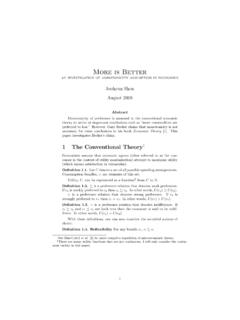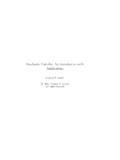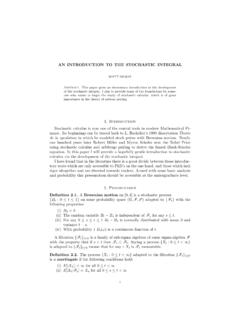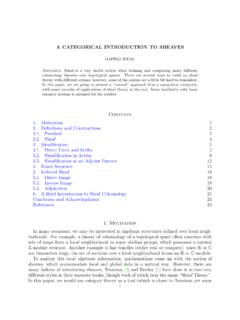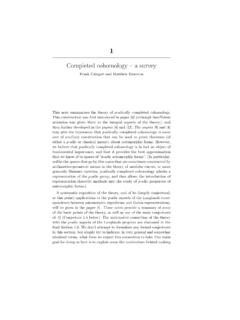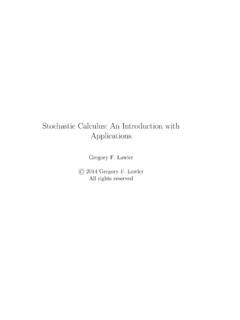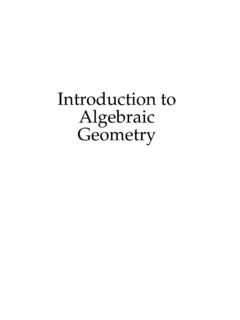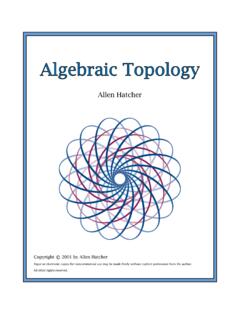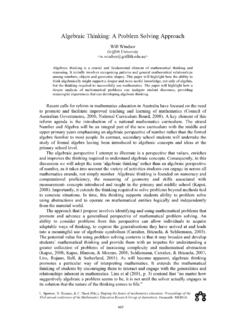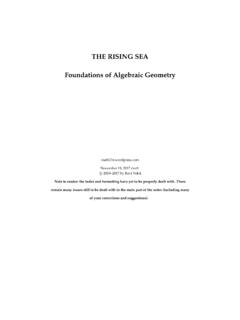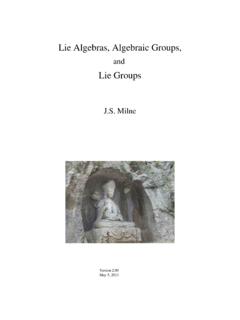Transcription of A Concise Course in Algebraic Topology J. P. May
1 A Concise Course in Algebraic TopologyJ. P. MayContentsIntroduction1 Chapter 1. The fundamental group and some of its applications51. What is Algebraic Topology ?52. The fundamental group63. Dependence on the basepoint74. Homotopy invariance75. Calculations: 1(R) = 0 and 1(S1) =Z86. The Brouwer fixed point theorem107. The fundamental theorem of algebra10 Chapter 2. Categorical language and the van Kampen theorem131. Categories132. Functors133. Natural transformations144. Homotopy categories and homotopy equivalences145. The fundamental groupoid156. Limits and colimits167. The van Kampen theorem178. Examples of the van Kampen theorem19 Chapter 3. Covering spaces211. The definition of covering spaces212. The unique path lifting property223. Coverings of groupoids224. Group actions and orbit categories245.
2 The classification of coverings of groupoids256. The construction of coverings of groupoids277. The classification of coverings of spaces288. The construction of coverings of spaces30 Chapter 4. Graphs351. The definition of graphs352. Edge paths and trees353. The homotopy types of graphs364. Covers of graphs and Euler characteristics375. Applications to groups37 Chapter 5. Compactly generated spaces391. The definition of compactly generated spaces392. The category of compactly generated spaces40vviCONTENTSC hapter 6. Cofibrations431. The definition of cofibrations432. Mapping cylinders and cofibrations443. Replacing maps by cofibrations454. A criterion for a map to be a cofibration455. Cofiber homotopy equivalence46 Chapter 7. Fibrations491. The definition of fibrations492. Path lifting functions and fibrations493.
3 Replacing maps by fibrations504. A criterion for a map to be a fibration515. Fiber homotopy equivalence526. Change of fiber53 Chapter 8. Based cofiber and fiber sequences571. Based homotopy classes of maps572. Cones, suspensions, paths, loops573. Based cofibrations584. Cofiber sequences595. Based fibrations616. Fiber sequences617. Connections between cofiber and fiber sequences63 Chapter 9. Higher homotopy groups651. The definition of homotopy groups652. Long exact sequences associated to pairs653. Long exact sequences associated to fibrations664. A few calculations665. Change of , weak equivalences, and a technical lemma69 Chapter 10. CW complexes731. The definition and some examples of CW complexes732. Some constructions on CW complexes743. HELP and the Whitehead theorem754. The cellular approximation theorem765.
4 Approximation of spaces by CW complexes776. Approximation of pairs by CW pairs787. Approximation of excisive triads by CW triads79 Chapter 11. The homotopy excision and suspension theorems831. Statement of the homotopy excision theorem832. The Freudenthal suspension theorem853. Proof of the homotopy excision theorem86 Chapter 12. A little homological algebra911. Chain complexes912. Maps and homotopies of maps of chain complexes913. Tensor products of chain complexes92 CONTENTSvii4. Short and long exact sequences93 Chapter 13. Axiomatic and cellular homology theory951. Axioms for homology952. Cellular homology973. Verification of the axioms1004. The cellular chains of products1015. Some examples:T,K, andRPn103 Chapter 14. Derivations of properties from the axioms1071. Reduced homology; based versus unbased spaces1072.
5 Cofibrations and the homology of pairs1083. Suspension and the long exact sequence of pairs1094. Axioms for reduced homology1105. Mayer-Vietoris sequences1126. The homology of colimits114 Chapter 15. The Hurewicz and uniqueness theorems1171. The Hurewicz theorem1172. The uniqueness of the homology of CW complexes119 Chapter 16. Singular homology theory1231. The singular chain complex1232. geometric realization1243. Proofs of the theorems1254. Simplicial objects in Algebraic topology1265. Classifying spaces andK( ,n)s128 Chapter 17. Some more homological algebra1311. Universal coefficients in homology1312. The K unneth theorem1323. Hom functors and universal coefficients in cohomology1334. Proof of the universal coefficient theorem1355. Relations between and Hom136 Chapter 18. Axiomatic and cellular cohomology theory1371.
6 Axioms for cohomology1372. Cellular and singular cohomology1383. Cup products in cohomology1394. An example:RPnand the Borsuk-Ulam theorem1405. Obstruction theory142 Chapter 19. Derivations of properties from the axioms1451. Reduced cohomology groups and their properties1452. Axioms for reduced cohomology1463. Mayer-Vietoris sequences in cohomology1474. Lim1and the cohomology of colimits1485. The uniqueness of the cohomology of CW complexes149 Chapter 20. The Poincar e duality theorem1511. Statement of the theorem151viiiCONTENTS2. The definition of the cap product1533. Orientations and fundamental classes1554. The proof of the vanishing theorem1585. The proof of the Poincar e duality theorem1606. The orientation cover163 Chapter 21. The index of manifolds; manifolds with boundary1651.
7 The Euler characteristic of compact manifolds1652. The index of compact oriented manifolds1663. Manifolds with boundary1684. Poincar e duality for manifolds with boundary1695. The index of manifolds that are boundaries171 Chapter 22. Homology, cohomology, andK( ,n) ( ,n)s and ( ,n)s and cohomology1773. Cup and cap products1794. Postnikov systems1825. Cohomology operations184 Chapter 23. Characteristic classes of vector bundles1871. The classification of vector bundles1872. Characteristic classes for vector bundles1893. Stiefel-Whitney classes of manifolds1914. Characteristic numbers of manifolds1935. Thom spaces and the Thom isomorphism theorem1946. The construction of the Stiefel-Whitney classes1967. Chern, Pontryagin, and Euler classes1978. A glimpse at the general theory200 Chapter 24.
8 An introduction toK-theory2031. The definition ofK-theory2032. The Bott periodicity theorem2063. The splitting principle and the Thom isomorphism2084. The Chern character; almost complex structures on spheres2115. The Adams operations2136. The Hopf invariant one problem and its applications215 Chapter 25. An introduction to cobordism2191. The cobordism groups of smooth closed manifolds2192. Sketch proof thatN is isomorphic to (TO)2203. Prespectra and the algebraH (TO;Z2)2234. The Steenrod algebra and its coaction onH (TO)2265. The relationship to Stiefel-Whitney numbers2286. Spectra and the computation of (TO) = (MO)2307. An introduction to the stable category232 Suggestions for further reading2351. A classic book and historical references2352. Textbooks in Algebraic Topology and homotopy theory235 CONTENTSix3.
9 Books on CW complexes2364. Differential forms and Morse theory2365. Equivariant Algebraic topology2376. Category theory and homological algebra2377. Simplicial sets in Algebraic topology2378. The Serre spectral sequence and Serre class theory2379. The Eilenberg-Moore spectral sequence23710. Cohomology operations23811. Vector bundles23812. Characteristic Hopf algebras; the Steenrod algebra, Adams spectral sequence23915. Cobordism24016. Generalized homology theory and stable homotopy theory24017. Quillen model categories24018. Localization and completion; rational homotopy theory24119. Infinite loop space theory24120. Complex cobordism and stable homotopy theory24221. Follow-ups to this book242 IntroductionThe first year graduate program in mathematics at the University of Chicagoconsists of three three-quarter courses, in analysis, algebra, and Topology .
10 The firsttwo quarters of the Topology sequence focus on manifold theory and differentialgeometry, including differential forms and, usually, a glimpse of de Rham cohomol-ogy. The third quarter focuses on Algebraic Topology . I havebeen teaching thethird quarter off and on since around 1970. Before that, the topologists, includingme, thought that it would be impossible to squeeze a serious introduction to al-gebraic Topology into a one quarter Course , but we were overruled by the analystsand algebraists, who felt that it was unacceptable for graduate students to obtaintheir PhDs without having some contact with Algebraic raises a conundrum. A large number of students at Chicago go into topol-ogy, Algebraic and geometric . The introductory Course should lay the foundationsfor their later work, but it should also be viable as an introduction to the subjectsuitable for those going into other branches of mathematics.
